Crane Basics
An offshore crane is defined as a pedestal-mounted elevating and rotating lifting device used to transfer materials and personnel to or from marine vessels, barges and structures, according to API Spec 2C, a standard used to design and manufacture offshore cranes. These offshore applications include bottom-supported, floating platform and ship-hulled vessels used in production and drilling operations, shipboard applications and heavy-lift applications.
The offshore oil and gas industry was established in 1954 with the first fixed platform installed near Morgan City, Louisiana in the Gulf of Mexico. The only cranes available for use on these early platforms were existing land-based construction machines with a tonnage naming convention based on maximum structural capacity, i.e. “100 ton crane. Unlike the land based cranes, offshore cranes are fixed structures incapable of moving with their loads. However, customers often make inquiries along the lines of, "We need a 100-ton crane". The next question becomes, "What is the definition of an 100-ton offshore crane?"
Because the offshore crane is a fixed structure, the distance from the crane at which the load is lifted is just as important as the magnitude of the load. In addition, lifting a load off a supply boat pitching in waves has the potential to subject the offshore crane to impact loads that would not be present when lifting off of the deck of the crane’s host facility. Consequently, the load capacity for supply boat lifts (offboard) are generally lower than those associated with lifting off the deck of the facility (onboard).
An offshore crane's capacity also depends on factors the purchaser must supply to the crane manufacturer. These include the type of structure upon which the crane is mounted (i.e. bottom-supported, semi-submersible, ship-hulled, etc.), the environmental conditions in the platform's location and the load's location in relation to the crane.
Crane Terminology
- Auxiliary (whip line or fast line): the secondary rope system capable of lifting a lower capacity than the main block
- Boom: connected to the upper structure and supports the hoist tackle
- Boom hoist: raises and lowers the boom
- Boom suspension: the collection of wire ropes, sheaves, shafts blocks and other rigging components used to support the boom
- Cab: where the operator maneuvers the crane's controls
- Gantry: a frame to which the boom support ropes are reeved
- Kingpost: connects to the platform and is the centerline of rotation for the upper structure
- Pedestal: the substructure the upper structure is mounted on
- Revolving superstructure: the rotating frame structure and the operating machinery mounted
*Definitions provided by API 2C
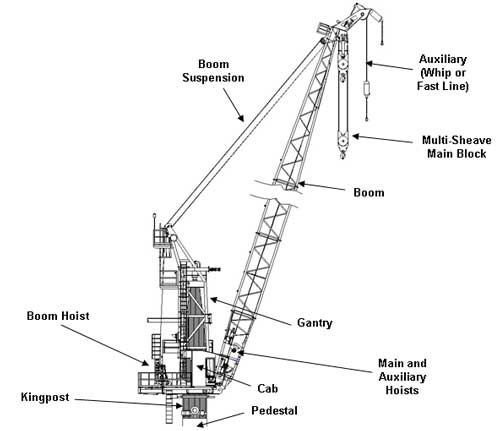
Duty Cycles
Offshore cranes can also be classified by duty cycle or the frequency of their use. The duty cycles include:
- Production Duty: annual operating time of 200 hours, typically on bottom-supported production platforms
- Intermediate Duty: annual operating time of 2,000 hours, typically on bottom-supported or floating platforms with temporary rigs
- Drilling Duty: annual operating time of 5,000 hours, typically on MODUs or floating structures that operate full time
-
Production Duty
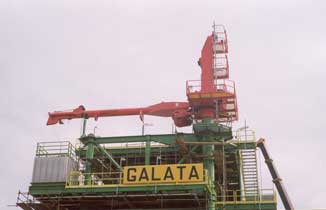
-
Intermediate Duty
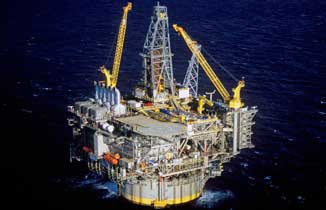
-
Drilling Duty
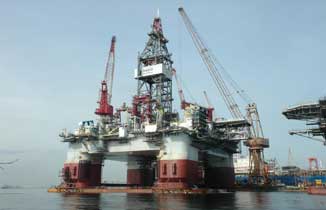
Methods Of Crane Support
For many years, cranes were supported on their foundations by roller bearings at their bases and are still commonly used on production duty applications. However, the kingpost design is the modern method for supporting high use cranes and/or those on floating installations and is the preferred arrangement for drilling duty and floating applications.
- Roller Bearing Type Cranes
- The revolving superstructure bolts on top of the roller bearing
- Roller bearing subject to full overturning moment from weight of load, the crane itself and boom
- Failure of bolts or the slew roller bearing can and has led to loss of operator, crane from its mount
- On floating applications, the bearing is subjected to load cycles from the crane self-weight and installation motions even when the crane isn't in use
- Replacement is costly and difficult to accomplish offshore
- Seatrax Kingpost-Type Cranes
- Revolving superstructure fits over and revolves around the kingpost
- Crane cannot separate from mount because of slew bearing failure
- No bolts = no bolt failure
- Bearings are easily replaced in the field using simple hand tools
- For more information on roller bearing versus kingpost cranes, review our technical paper Support Bearing Comparison: Ball vs. Kingpost.
Winches/Hoists
Seatrax Draw-Works Type Band Brake Hoist for High Duty Cycles
- Reduction gearing and brakes are mounted externally
- Drum is driven by a solid, one-piece hardened alloy shaft and hoist drum spline connection
- No periodic internal inspections are required or recommended
- The hydraulic dynamic brake is at the hydraulic motor input, and the band brake acts directly on the drum, so no single failure in either brake can render both braking systems ineffective
For more information on Seatrax hoists, click here.
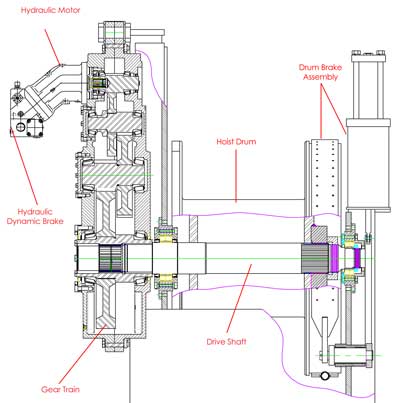
Conventional Production Duty "Works in the Drum" Winches
- Planetary reduction gearing and static brake mechanisms mounted inside the drum barrel
- Winch must be removed from its mount and completely disassembled for inspection or replacement of the brake, gearing and other load transmitting components
- Manufacturers of this type of hoist typically mandate periodic removal and internal inspection
- Both the hydraulic dynamic brake and the mechanical brake are located at the input, so a single internal failure in the driveline can render both brakes ineffective
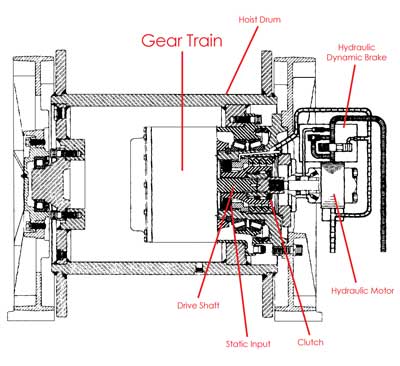
Hydraulic System Types
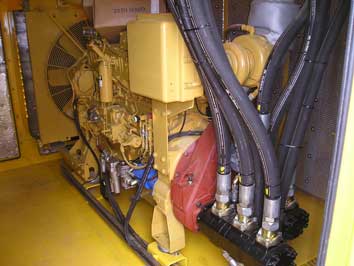
Fixed Displacement
- Offshore crane mounted on fixed structure typically operates for 150-300 hours per year
- Marine crane used to support drilling operations typically accumulates 3,000-5,000 hours per year
- Fixed displacement gear type hydraulic system works well for many years on fixed platform given low cumulative hours
- Because of the cumulative hours and number of hours run during drilling cycle, fixed displacement gear type hydraulic system provides limited service life and performance on a drilling support crane
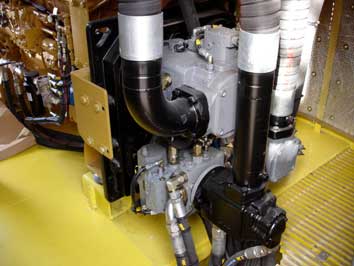
Variable Displacement
Variable displacement (medium flow) advantages over fixed displacement include:
- Provides up to 50%+ faster operational speeds
- Provides 400%+ greater hydraulic component life
- Improved controllability for the operator
- Quieter operation. (Approximately 72 dba vs. 85-90 dba in the cab w/open wingdeck)
- Combine the advantages above to translate to greater safety
For more information, review our technical paper Fixed vs. Variable Displacement Hydraulic Systems.
Boom Support Types

Continuously Reeved
The suspension wire rope runs from sheaves in the gantry directly to sheaves in the boom tip. The advantage of this approach is that it puts less dynamic loading into the sheaves, but it requires longer wire rope, making rope replacement cost more.
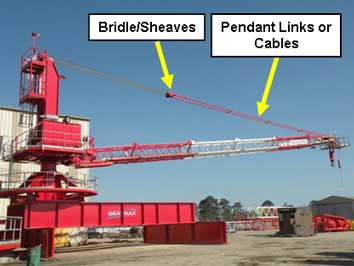
Pendant and Bridle
The suspension wire rope runs from sheaves in the gantry to a suspended sheave cluster which attaches to the boom tip with static links or cables. The advantage is that it requires less wire rope, but heavy duty steel sheaves and bearings should accompany this arrangement.
